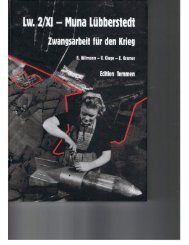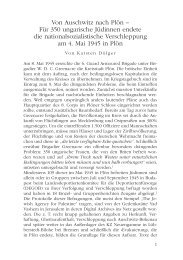The Kallos Family Book 2022
Always remember and tell the story to the world
Always remember and tell the story to the world
- TAGS
- barbara lorber
You also want an ePaper? Increase the reach of your titles
YUMPU automatically turns print PDFs into web optimized ePapers that Google loves.
32 • THE KALLOS FAMILY
investigations by Germany into violent crimes
committed by the three Nazi commanders and
various SS female guards at Lübberstedt–Bilohe
(see Appendix 1 for the English transcript of
Barbara Kallos’ testimony). Numerous other survivors
of Lübberstedt–Bilohe also gave evidence,
including the four Ickovic family members who,
in 1969, were interviewed by German investigators
in New York at the offices of the German
consulate. The investigating prosecutor in
Germany remarked that ‘War crimes were committed
in Lübberstedt, but survivors were not
able to give enough information to the police
that would enable them to identify the perpetrators’.
Too much time had passed between the
end of the war and the investigations, they said.
A stay of proceedings was declared by the prosecution
on 3 October 1974. Today the records of
these investigations are kept at the Ludwigsburg
branch of the German Federal Archives.
The survivors
The Kallos family
The surviving Kallos family members – Lili,
Biri and Laci, and Lili’s sister Ilonka – briefly
returned to Ťačovo to look for Zoltan. Laci was
the first to return in February 1945; the rest of
his immediate family remained in captivity for
another three months, until the war ended. Laci,
who had been separated from Zoltan after their
arrival in Birkenau, worked as a forced labourer
in the Jaworzno concentration camp coal mines.
In January 1945 the prisoners of Jaworzno
were forced on a hellish death march westward
towards Germany. On the fourth day of the
march, when the Nazis stopped at Blechemmer
camp to rest, Laci managed to escape with a
small group of young survivor male friends. Just
before it was liberated by the Russians Blechemmer
was in a state of chaos. Although Laci was
shot in the shoulder in the escape, he was able
to continue.
Laci’s return journey to Ťačovo was another
unimaginable nightmare. Without appropriate
footwear and clothing, he, with the other escapees,
trudged through snow in freezing winter
temperatures. Fortunately, one adult, Laci’s
uncle Elek Kallos and his son Gaby, was also in
the group. Suffering constant hunger, stomach
cramps and diarrhoea, they scavenged for food,
especially bread, sheltered in abandoned houses
in Nazi occupied Poland where Germans had
been living, managed to avoid stray German soldiers,
and had to prove to Russian soldiers (by
showing their numerical tattoo) that they were
freed Jewish prisoners and not the enemy. All
this and not to mention the heartbreak of wondering
who they would find – or if they would
find anyone – at home.
Finally, on a train heading towards Czechoslovakia,
which was still not fully liberated (Prague
was under Nazi rule until 9 May 1945), the survivors
sang the Czech national anthem and shed
a tear. On the last leg of their return journey,
at the major railway hub in the city of Čop in
Slovakia they caught the local train that crossed
the border into Sub Carpathian Ruthenia, which
had already been liberated by the Russians
in October 1944. Due to overcrowding, Laci,
together with his old neighbourhood friend Eli
Reisman, spent that February train ride on the
outside top of the carriage in freezing temperatures.
As a result, they arrived in Ťačovo half
frozen. Laci, 16 years old, weighed only 28 kilos.
He walked to the family hotel near the
station, but the Russians, who now occupied the
hotel, would not let him stay there.
Laci and Eli managed to sleep in tailor
Ickovic’s house, which had been stripped and





